Physical Address
304 North Cardinal St.
Dorchester Center, MA 02124
Since the last natural smallpox infection, reported in Somalia in 1977, human poxvirus infections (other than molluscum contagiosum) have only been observed sporadically either after vaccination with poxvirus officinalis (vaccinia virus), or due to zoonotic poxviruses, such as monkeypox, catpox, or tanapox virus. As it is highly lethal and infectious, smallpox virus is feared for its potential use by bioterrorists.
Smallpox epidemics have decimated whole populations since antiquity. Smallpox has been demonstrated in Egyptian mummies. Indian (Shitala) and African / Afro-American (Shapanan) divinities share the characteristics of both deadly disease and protection of the person who has already survived the disease. In 1798, Edward Jenner made use of the observation that milkers who had contracted cowpox did not suffer from smallpox. This was the beginning of vaccination – that is, the inoculation of cowpox virus in order to protect against smallpox (Latin: vacca = cow). Smallpox eradication is the greatest success story of the World Health Organization (WHO). Once eradication was declared by the WHO in May 1980, compulsory vaccination was generally abandoned. Monkeypox was initially recognized in 1958 in captive primates. The first human cases were reported in 1970 in the Congo. Since then, monkeypox has been reported sporadically in humans in Africa but not outside Africa until 2003, when the infection first appeared in the USA.
Tanapox virus was first recognized in 1957 after an outbreak among schoolchildren in Kenya, in a village of the Tana river valley. Indications for smallpox vaccination have been newly established in order to prepare for bioterroristic attacks as well as to prevent monkeypox, as this has been imported into the USA.
Poxviruses that can affect humans comprise four main genera : orthopox, yatapox, parapox, and molluscipox virus ( Table 13-1 ). Orthopox viridae are endemic in many animals throughout the world. The natural hosts of poxviruses are usually rodents, which can occasionally transmit the virus to humans. Monkeypox is a zoonotic poxvirus infection endemic in Africa; it was imported from Ghana to the USA in 2003 by infected Gambia giant rats and transmitted to prairie dogs and humans. Although human-to-human transmission of monkeypox may occur, further spread among humans is limited. Other zoonotic poxvirus infections occur sporadically (e.g., cowpox or catpox). These orthopox viruses usually cause self-limited infections, but may become life threatening in immunocompromised patients or subjects suffering from a predisposing skin disease. This also applies to the virus used for vaccination against smallpox, P. officinale (vaccinia virus). This virus may sometimes be inadvertently transmitted from a smallpox vaccinee to another individual.
| Genus and Species | Primary Reservoir | Other Hosts | Geographic Region | Mode of Transmission | Protection Provided by Vaccinia Vaccination |
|---|---|---|---|---|---|
| ORTHOPOX VIRUS (OPV) | |||||
| Smallpox (variola major-virus), alastrim (variola minor-virus) | High-security laboratories in Russia and USA | Declared eradicated in 1980 Maintained in high-security laboratories in USA and Russia |
Direct contact, respiratory droplets | Yes | |
| Vaccinia (poxvirus officinalis) a | Laboratories producing dermovaccine | Direct contact, inoculation | |||
| Cowpox / catpox (OPV bovis) | Rodents | Ungulates, cats | Europe, Africa, central and northern Asia | Direct contact | Yes |
| Monkeypox (OPV simiae) | Rodents | Monkeys, apes, prairie dogs, other mammals (?) | Central and West Africa | Direct contact, respiratory droplets | Yes |
| Other OPV | Rodents | Mammals (ungulates, camels, elephants, raccoons, voles, dogs, cats), birds | Worldwide? | Direct contact | Yes |
| YATAPOXVIRUS (YPV) | |||||
| Tanapox | Non-human primates | Central and East Africa | Direct contact | No | |
| Yabapox | Non-human primates | Central Africa | Direct contact | No | |
| PARAPOXVIRUS (PPV) | |||||
| Pseudocowpox (milkers' nodules and paravaccinia) | Ungulates | Worldwide | Direct contact | No | |
| Bovine papular stomatitis | Ungulates | North America, Africa, Australia, New Zealand, Europe | Direct contact | No | |
| Orf | Ungulates | North America, New Zealand, Europe | Direct contact | No | |
| Sealpox | Seals | Atlantic and Pacific Ocean, North Sea | Direct contact | No | |
| MOLLUSCIPOXVIRUS | |||||
| Molluscipox (molluscum contagiosum) | Humans | Worldwide | Direct contact | No | |
a It is not clear whether the modified orthopoxvirus cultured for smallpox vaccination originates from a cowpox or an equine orthopoxvirus.
Non-orthopox viruses comprise pseudocowpox (milker's nodules) and yatapox viruses, including tanapox virus. Human tanapox occurs sporadically in Africa or in individuals handling laboratory animals. Tanapox is acquired by direct contact with infected non-human primates, and the infection cycle appears to be maintained between primates and mosquitoes.
For molluscipox virus causing molluscum contagiosum, the distribution is worldwide, and it is not considered to be a tropical disease.
Poxvirus penetrates into the organism by virus-containing material coming into contact with the skin or with the respiratory tract (smallpox and monkeypox). Smallpox virus replicates at the site of contact and in the local lymph nodes. Subsequently, primary viremia develops, followed by multiplication of the virus in the reticuloendothelial system during the incubation period. Secondary viremia is accompanied by fever and the cutaneous eruptions appear.
Poxviruses typically produce skin lesions, initially presenting as maculae or papules that evolve to become vesicles and pustules, which eventually dry up, forming a crust. The multifaceted clinical pictures due to poxviruses and the clinical course of smallpox are shown in Figure 13-1 and Tables 13-2 to 13-3 . Complications after smallpox vaccination also share features with smallpox eruptions. When the infection is acquired by inoculation, either by inadvertent contamination of a preexisting skin injury or by vaccination, a primary lesion appears on the respective site.
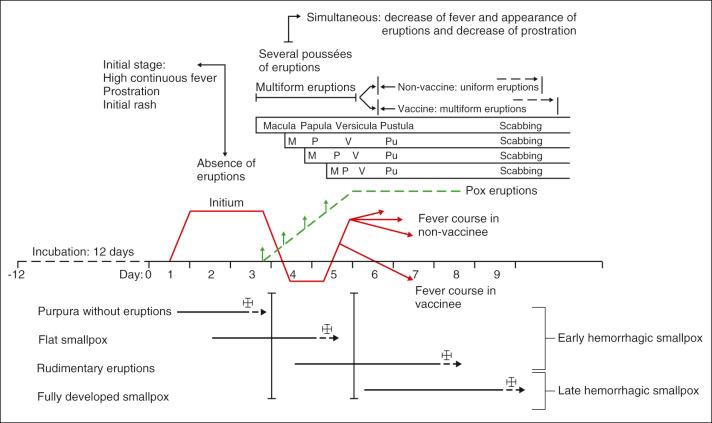
| Smallpox |
|
| Vaccinia |
|
| Monkeypox and other zoonotic orthopoxvirus infections |
|
| Milker's nodule and paravaccinia Tanapox |
Multiple stages: usually resolve within 6 weeks |
| Date | Stage | Skin Eruptions | Skin Eruptions Indicating Complications | Contagiousness | Figures |
|---|---|---|---|---|---|
| −12 (−7 to −17) to 0 days | Incubation | None | |||
| 0–2 | Initial / prodromal stage | High continuous fever and prostration Initial morbilliform rash and enanthem (mouth), easily overlooked |
Early hemorrhagic smallpox (purpura variolosa), leading to death | Yes | Flat smallpox Purpura variolosa |
| 2–3 | M | High | Macular eruption | ||
| 4–5 | Eruptive stage: multiform eruptions | Different generations of M, P, V Fever recrudescence |
Flat-type (rudimentary) pustules, (semi)confluent eruptions, leading to death | High | Multiform early eruptions |
| 6–10 | Uniform appearance and postulation a | Pu | Flat eruptions, leading to death Hemorrhage into eruptions (late hemorrhagic smallpox), leading to death |
Highest | Uniform vesicles Uniform pustules Hemorrhagic vesicles (late hemorrhagic smallpox) |
| 11– | Desiccation of eruptions | C and scarring | After scabs have fallen off, patients are no longer contagious | Crust |
For smallpox surveillance the Centers for Disease Control and Prevention (CDC) has established a case definition and various probability categories for smallpox ( Table 13-4 ). Monkeypox eruptions resemble those due to smallpox, but the clinical picture is usually less severe ( Figs. 13-2 and 13-3 ). In immunocompromised hosts, small children, and infants, however, monkeypox is life threatening. As with smallpox, monkeypox may present as a primarily hemorrhagic infection. The reported lethality in Africa reaches 15% and more; breast-fed infants of monkeypox-infected mothers and malnourished children are at particular risk. Also as with smallpox, generalized eruptions appear only after 2–3 days of febrile illness (see Fig. 13-3 ). In other zoonotic poxvirus infections, a primary lesion appears at the inoculation site, and the clinical course is mild if the patient is immunocompetent.
| CDC smallpox case definition | An illness characterized by an acute onset of fever (38.3°C / 101°F) followed 1–4 days later by a rash with firm deep-seated vesicles or pustules in the same stage of development without other apparent cause a |
| High probability is defined by a febrile prodrome and classical smallpox lesions and uniformity of lesions (lesions at the same stage of development) | |
| Moderate probability of smallpox is defined by a febrile prodrome and either one other major smallpox criterion or four minor smallpox criteria | |
| Low probability of smallpox is defined by the presence of fewer than four smallpox criteria, whether or not preceded by a febrile prodrome | |
| Major smallpox criteria | Febrile prodrome occurring 1–4 days before rash onset, fever ≥ 38.3°C (101°F) and at least one of the following: prostration, headache, backache, chills, vomiting, or severe abdominal pain |
| Classic smallpox lesions: deep-seated firm, hard, round well-circumscribed vesicles or pustules; as they evolve, lesions become umbilicated or confluent | |
| Lesions in the same stage of development: on any part of the body (e.g., the face or arm); all the lesions are in the same stage of development (i.e., all are vesicles, or all are pustules) a | |
| Minor smallpox criteria | Centrifugal distribution, greater concentration of lesions on the face and on distal extremities |
| First lesions on the mucosal palate, face, or forearms | |
| Patient appears septic or moribund | |
| Slow evolution: lesions evolve from vesicles to papules–pustules over days (each stage lasts 1–2 days) | |
| Lesions on the palms and soles | |
| CDC laboratory criteria for confirmation | PCR identification of variola DNA in clinical specimen; or |
| Isolation of smallpox (variola) virus from a clinical specimen (WHO smallpox reference laboratory or laboratory with appropriate reference capabilities) with variola PCR confirmation |
a Authors' note: it must be emphasized that at the beginning of a rash the lesions are not yet uniform, but become so after 2 days. In vaccinees the multiform picture may persist for the whole course of the disease.
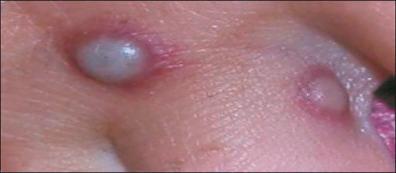
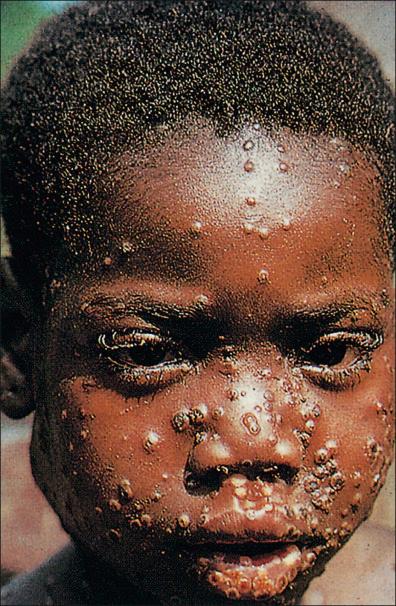
Tanapox virus infection is usually a mild self-limiting disease that shares the febrile prodromal stage with other poxvirus infections. In tanapox, the prodrome is mild and may be accompanied by headache and myalgia. Towards the end of the febrile phase, a mostly solitary erythematous macule appears. As the fever wanes, a papule appears and this expands to a diameter of approximately 1 cm. The center may become umbilicated, develop a necrotic crust, or deepen and form a nodule. On light skins the expanding nodule is surrounded by a reddish halo ( Fig. 13-4 ). Regional lymphadenopathy appears 4–5 days after the appearance of the papule. The lesion can be extremely tender, and it may also be pruritic. The maximal diameter (approximately 2 cm) is reached at the end of the second week. From this point the lesion slowly involutes with the whole evolution–involution taking 6 weeks, leaving a small scar.
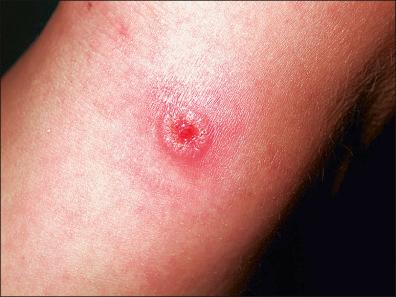
Smallpox is likely to be initially misdiagnosed because clinicians are no longer familiar with the features of these infections. Because of the high lethality and infectivity of smallpox, it is necessary to differentiate smallpox as soon as possible from other diseases with vesicular eruptions, especially chickenpox. The CDC has therefore provided an algorithm for the probability of smallpox and for the differential diagnosis of papulovesicular eruptions : a highly suspicious smallpox case is defined by an illness characterized by acute onset of fever (38.8°C / 101°F) followed 1–4 days later by a centrifugal rash with firm deep-seated vesicles or pustules in the same stage of development without other apparent cause (see Table 13-4 , Fig. 13-5 ). The occurrence of a febrile prodrome before generalized eruption is an equally important criterion for monkeypox and catpox / cowpox. The suspicion of zoonotic poxvirus infections is raised by contact with animals (e.g., prairie dogs, cats, or other animals) that can transmit poxviruses ( Table 13-5 ). The potentially transmitting animal must be traced and investigated for symptoms of poxvirus infection. Unique clinical features of tanapox are the nodular nature of tender lesions, the paucity of lesions, the lack of pustulation, the benign course of the disease, and the prolonged resolution of the rash. Vaccinia (disease due to inoculation of the smallpox dermovaccine) is suspected when a smallpox vaccination has been administered or when the patient was in contact with a smallpox vaccinee within less than 21 days (inadvertent inoculation). For differential diagnosis of poxvirus infection versus other papulovesicular eruptions, see Table 13-6 and Figs. 13-5 to 13-18 .
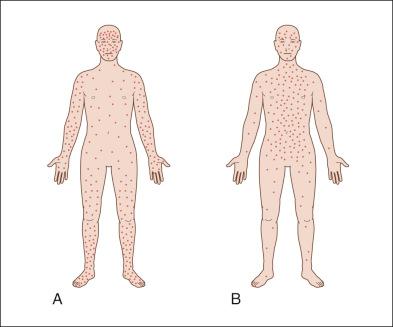
| CLINICAL CRITERIA |
|
| EPIDEMIOLOGIC CRITERIA |
| LABORATORY CRITERIA |
|
| CASE CLASSIFICATION |
| Suspect Case |
|
| Probable case |
|
| CONFIRMED CASE |
|
| EXCLUSION CRITERIA |
A case may be excluded as a suspect or probable monkeypox case if:
|
a Includes living in a household, petting or handling, or visiting a pet-holding facility (e.g., pet store, veterinary clinic, pet distributor).
b Includes prairie dogs, Gambian giant rats, and rope squirrels. Exposure to other exotic or non-exotic mammalian pets will be considered on a case-by-case basis; assessment should include the likelihood of contact with a mammal with monkeypox and the compatibility of clinical illness with monkeypox.
c Includes living in a household, or originating from the same pet-holding facility as another animal with monkeypox.
d Includes skin-to-skin or face-to-face contact.
e Factors that might be considered in assigning alternate diagnoses include the strength of the epidemiologic exposure criteria for monkeypox, the specificity of the diagnostic test, and the compatibility of the clinical presentation and course of illness for the alternative diagnosis.
f If possible, obtain reconvalescent-phase serum specimen from these patients. See specimen collection guidelines ( http://www.cdc.gov/poxvirus/monkeypox/clinicians/prep-collection-specimens.html ) for details on collecting serum for convalescence evaluation.
| Chickenpox | Smallpox | Smallpox in a Vaccinee (Varioloid) | Monkeypox | |
|---|---|---|---|---|
| MEDICAL HISTORY | Contact with other individual with chickenpox | Contact with individual with smallpox Laboratory worker Suspicion of bioterrorism |
Contact with pet prairie dogs or Gambia rats Close contact with humans with monkeypox |
|
| APPEARANCE OF LESIONS | At fever peaks; prodrome, if present, mild first lesion with lymph node swelling | 2–3 days after onset of fever, when fever decreases | Possibly inoculation site: first lesion with lymph node swelling Generalization, 1–3 days after onset of fever |
|
| PICTURE OF RASH | Multiform rash (“starry sky”) Development of lesions, each evolving without synchronization |
Transient multiform rash for 2–3 days M-P-V-Pu-C with subsequent synchronization and uniform rash |
Persistent multiform rash M-P-V-Pu-C | Uniform evolution of lesions (M-)P-V-Pu-C |
| MORPHOLOGY OF VESICLES | Not chambered vesicle: “dewdrop on a rose petal” | Chambered deep-seated umbilicated vesicle (vesicle with “belly bottom”) | Chambered but abortive | Chambered umbilicated vesicle |
| DISTRIBUTION OF LESIONS | Centripetal = maximum density of lesions: trunk Rarely on palms and soles |
Always centrifugal distribution of lesions Maximum density of lesions: extremities, head Lesions also appear on palms and soles |
In many but not all patients there is centrifugal distribution of lesions Maximum density of lesions: extremities, head Lesions also appear on palms and soles |
Centrifugal generalized rash, maximum density of lesions: extremities + lesion at inoculation site Lesions may appear on palms and soles |
| EVOLUTION OF LESIONS | More rapid (from vesicle to crust even within 24 h) | Slow (each stage lasts 1–2 days) | Slow (each stage lasts 1–2 days) | |
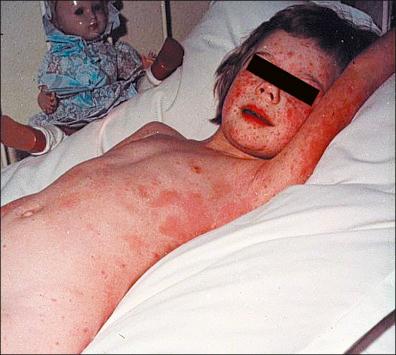
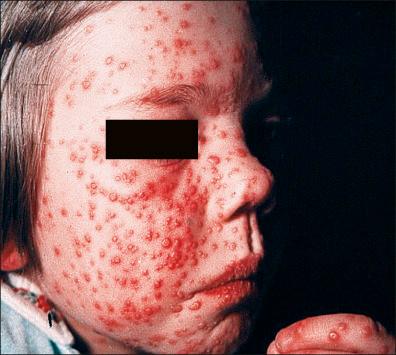
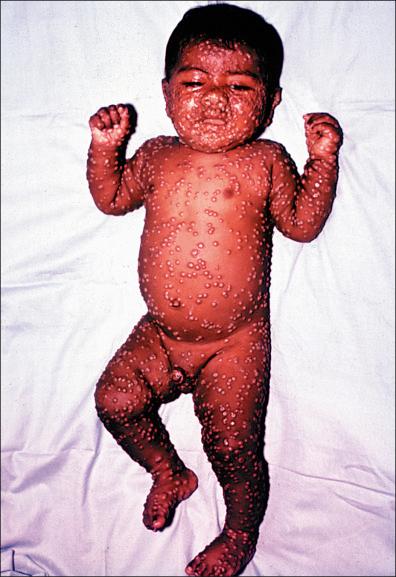
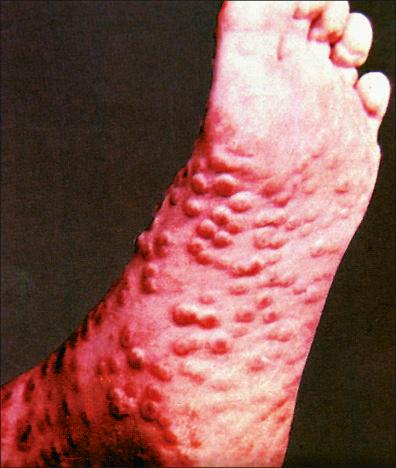
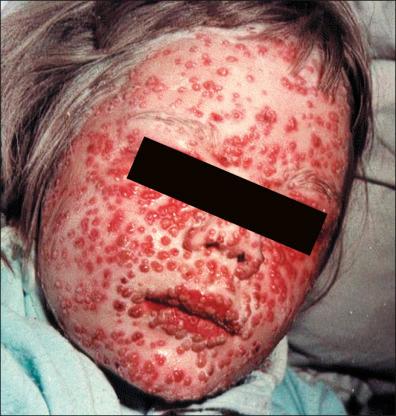
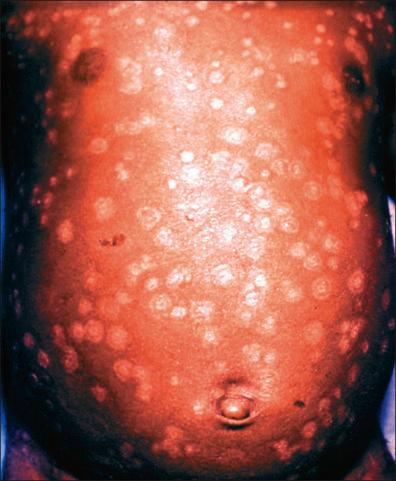
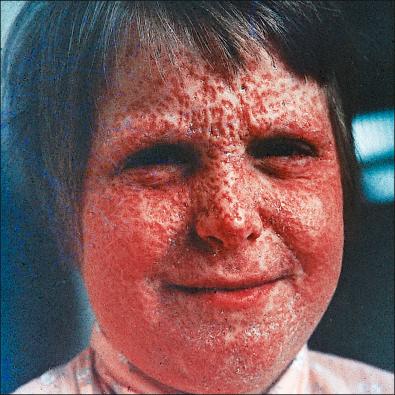
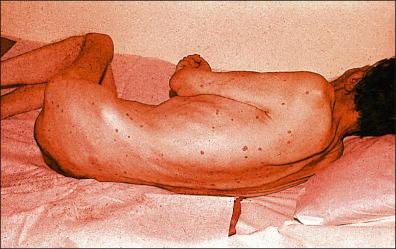
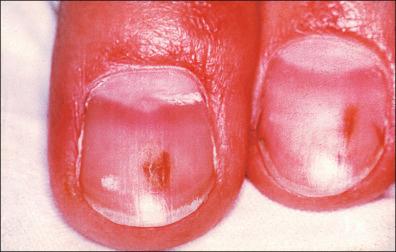
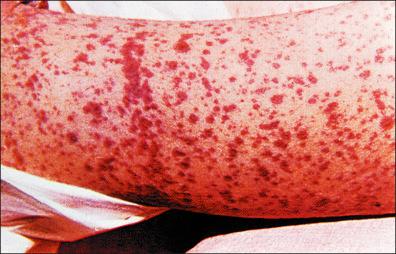
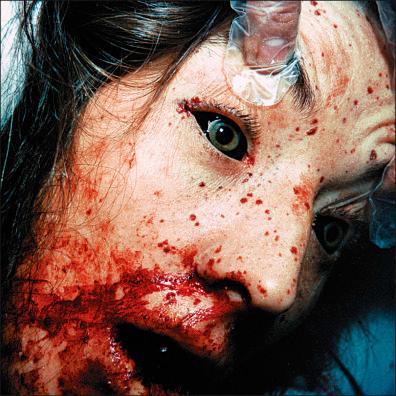
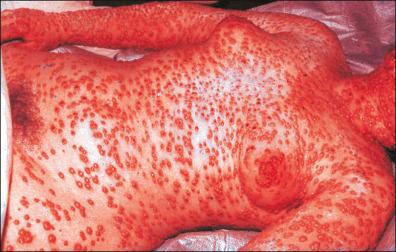
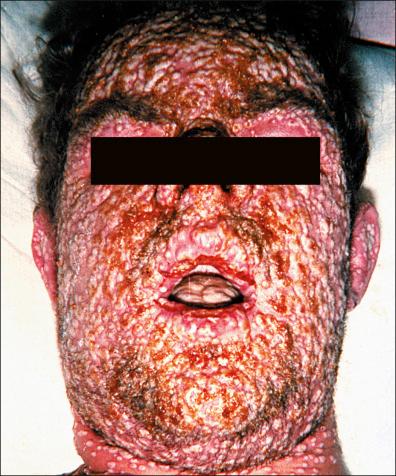
Other differential diagnoses comprise generalized herpes simplex or herpes zoster, impetigo, drug eruptions, and erythema multiforme. In rickettsialpox, an eschar (inoculation site with a black scar) is seen; this may sometimes be difficult to distinguish from an inoculation site of a poxvirus infection. Rickettsialpox rapidly responds to doxycycline. The typical symptom of scabies is intense itching, especially at night, whereas pox eruptions are painful and lesions are tender to palpate. Scabies and molluscum contagiosum are not accompanied by fever. Early (flat) hemorrhagic smallpox (see Figs. 13-13 to 13-16 ) and hemorrhagic monkeypox must be differentiated from fulminant meningitis, viral hemorrhagic fevers, and acquired immunodeficiency syndrome (AIDS) with thrombocytopenia and disseminated herpes virus infections.
Smallpox-vaccine-associated adverse events may be due to the vaccinia virus itself or to autoimmune processes induced by the virus, or may represent non-specific allergic side-effects to other vaccine components (erythema multiforme major / Lyell syndrome), or may be a bacterial superinfection (see Table 13-2 ). The suspicion is raised by the history of smallpox vaccination of the individual or a contact person, because inoculation of vaccinia virus may occur inadvertently from a vaccinee to another individual.
Laboratory investigation must be performed in high-security laboratories. Security criteria for vaccinia virus, monkeypox virus, and smallpox virus have been defined by the CDC. Suitable material for diagnostic examinations includes vesicle fluid from the eruptions and tissue samples. Orthopox virus belongs to the largest viruses in nature ( Fig. 13-19 ). They are visible even with an optical microscope. Electron-microscopically, orthopox viruses are brick shaped. All orthopox viruses have a similar appearance and are not morphologically distinguishable. Polymerase chain reaction (PCR) assay is performed in specialized centers. Tissue samples may be inoculated onto primary and continuous cell lines, including rhesus-monkey kidney cells, rabbit kidney cells, VERO cells, and other cells. Cytopathic changes are observed in those cell lines within 1–4 days. Samples may also be inoculated onto rabbit skin. A PCR assay that amplifies a conserved segment of the DNA polymerase gene ( E9L ) that is present in all Old-World orthopox viruses except variola allows the differentiation between monkeypox and smallpox viruses. Further combined PCR tests allow the characterization of orthopox virus species, and, for example, in monkeypox the subclassification of monkeypox virus strains. Tests for antibodies against poxviruses do not allow the differentiation between antibodies against vaccinia virus in vaccines, or between monkeypox virus and smallpox virus infection.
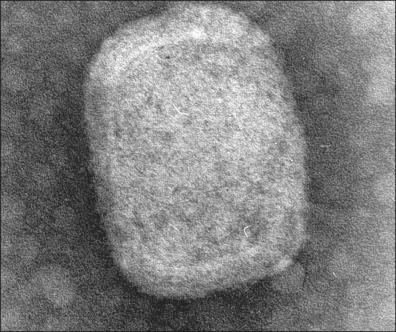
Become a Clinical Tree membership for Full access and enjoy Unlimited articles
If you are a member. Log in here